Capturing the power of water
Posted by Nandine Kanesalingam on September 15, 2014
For thousands of years, people around the world have been capturing the power of moving water to create mechanical or electrical power for grinding wheat into flour, sawing wood and powering both textile mills and manufacturing plants.
The modern design of a hydroelectric power generating station was established by French hydraulic and military engineer Bernard Forest de Bélidor in the mid-1700s. In his four volume work, Architecture Hydraulique, Bélidor described the technology that could be used to harness the power of falling water to create hydroelectricity[1].
Major developments in hydropower began to really take shape in the late 19th century. In 1880, Michigan's Grand Rapids Electric Light and Power Company began generating electricity with a water turbine to light up 16 brush-arc lamps at the Wolverine Chair Factory.
In 1881, city street lamps in Niagara Falls, New York, started to be powered by hydropower and in 1882, the world's first hydroelectric power plant began operation on the Fox River in Appleton, Wisconsin. By 1886, there were about 45 water-powered electric plants in the U.S. and Canada[2].
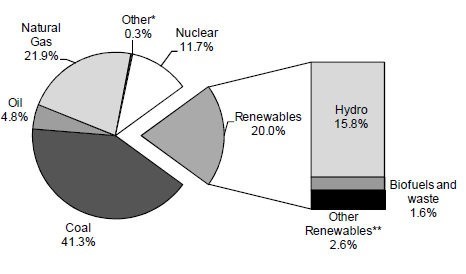
Figure 1 Global Electricity Capacity 2011[3]
Today, renewable energy is used for nearly 20 per cent of the world’s electricity production and hydroelectric power accounts for 15.8 per cent of that production (Figure 1). The share of hydropower energy supply could potentially double by 2050, jumping from 999 GW net installed capacities to 2000 GW (Figure 2). This increase is driven by a global initiative to mitigate the effect of 3 billion tonnes of carbon emissions annually. Most of this increased capacity will come from large hydro plant facilities in poor income and emerging countries who are trying to address energy poverty in a sustainable manner[4].
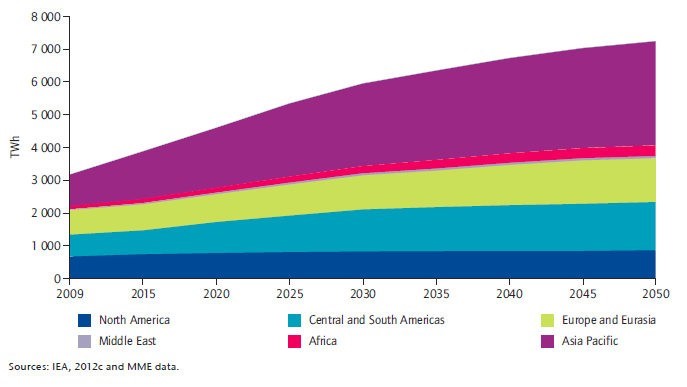
Figure 2 Projection of Hydroelectricity Generation until 2050[5]
Diversity of Hydropower
There are three types of hydropower facilities: impoundment, run-of-river and pumped storage. Each of these facilities differs in generating capacity, size and design and for hydro power to be economically feasible and efficient, the right topography must be considered.
The most common type of hydroelectric power plant is an impoundment facility. An impoundment facility, typically a large hydropower system, uses a dam to store river water in a reservoir. Water released from the reservoir flows through a turbine, spinning it, which in turn activates a generator to produce electricity[6] (Figure 4).
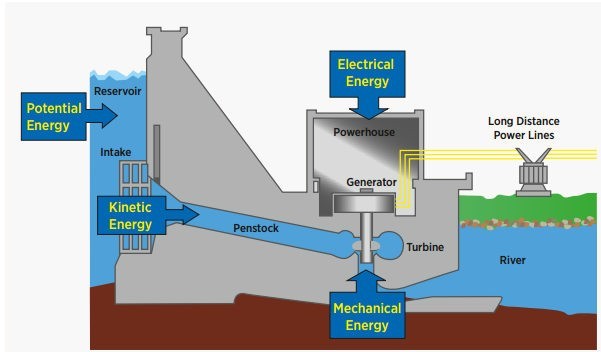
Figure 4 Hydropower Station with a Dam and Reservoir[7]
Run-of-river systems produce electricity by the natural flow and elevation drops of a river. A portion of the river’s flow is diverted using a weir through a canal or a penstock leading the water to the turbine (Figure 5).
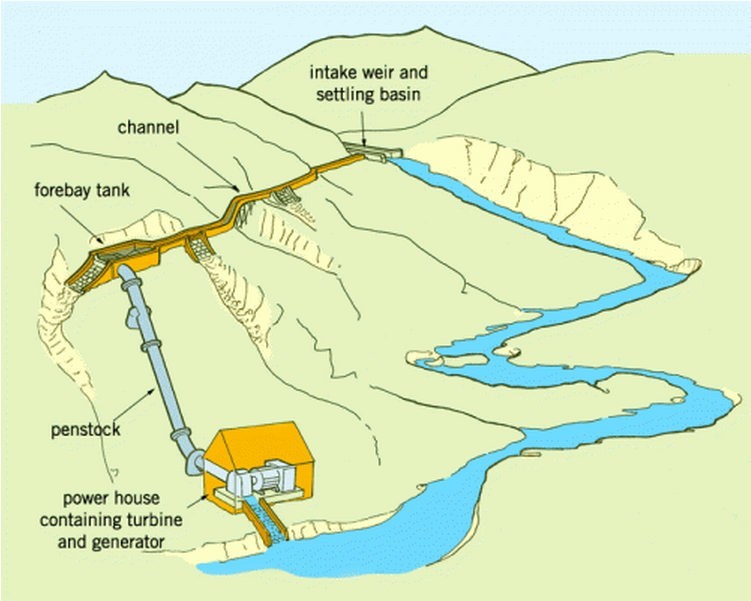
Figure 5 Run-of-River Hydro Station[8]
Pumped storage facilities use the excess power generated to pump water from the lower reservoirs back to higher reservoirs, for later use during peak periods[9]. The turbine that is used to generate the electricity also acts as a pump, a surplus in the grid switches the turbine to pump mode (Figure 6).
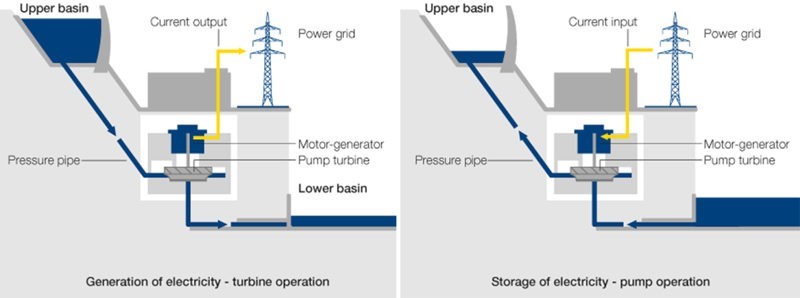
Figure 6 Pumped Storage Facility[10]
The hydropower plant facilities can be divided into three systems: electrical, mechanical and structural. The structural system is the dams, weirs and powerhouse required to produce hydroelectricity. The electrical system involves the generation of electricity from the conversion of mechanical energy. Hydropower facilities produce electricity by using the kinetic energy of water that flows through a penstock or channel to a turbine, the mechanical system. The force of the water spins the blades of the hydraulic turbines which are connected to generators with a drive shaft. The motion created by the turbine causes the electromagnets in the generator to spin it then interacts with coils to convert the mechanical energy into electricity; this is the electrical system[11]. This process of electricity generation is consistent for the three hydropower stations. Hydropower is very efficient, most modern stations are capable of converting over 95 per cent of available energy into electricity[12].
Economics
Hydropower is a mature technology but it is still a capital intensive energy system and requires a lengthy period for development and construction due to the significant planning, designing, environmental and social assessments and civil engineering work required. There are two significant cost components to hydropower projects: civil engineering work (dams, tunnels and powerhouse) and electromechanical work, including equipment and distribution systems. The total cost also varies significantly depending on the location of the potential site.
Environmental and Social Impact
Hydropower has no emissions from the production of electricity at the hydropower plants, as the fuel used is water, however, the construction and operation of the large-scale dams and diversion of water does have an impact on the environment. The environmental and social issues identified by the IEA include
- safety,
- water use and quality,
- impacts on migratory species and biodiversity,
- life cycle greenhouse gas emissions, and
- size of hydro projects[13].
Hydropower provides communities with a sustainable and consistent supply of electricity, at a competitive, low cost. However, there are implications for the natural landscape, wildlife and population settlements in areas where hydropower facilities are constructed. The size of the facilities in some cases requires communities to be relocated in order to avoid the risk of flooding or if they are in close proximity to the areas required for the development. It is important to involve the local communities throughout the planning of these large projects to ensure that proper planning is done with the community’s interests in mind. Having public acceptance is crucial to hydropower development projects as the perception of these communities influence the regulations set by governmental institutions.
Hydropower has great potential for emerging nations and is a key technology to mitigate climate change. Hydroelectricity is highly reliable, efficient and flexible with storage capabilities and it’s a proven technology that many nations can greatly benefit from.
[1] Office of Energy Efficiency & Renewable Energy, "History of Hydropower," U.S. Department of Energy, [Online]. Available: http://energy.gov/eere/water/history-hydropower.
[2] Office of Energy Efficiency & Renewable Energy, "History of Hydropower," U.S. Department of Energy, [Online]. Available: http://energy.gov/eere/water/history-hydropower.
[3] Sustainable Energy For All, "Global Tracking Framework," Sustainable Energy For All, 2013.
[4] IEA, "World Energy Outlook 2012," International Energy Agency/ OECD, Paris, 2012.
[5] IEA, "World Energy Outlook 2012," International Energy Agency/ OECD, Paris, 2012.
[6] Office of Energy Efficiency & Renewable Energy, "Types of Hydropower Plants," U.S. Department of Energy, [Online]. Available: http://energy.gov/eere/water/types-hydropower-plants.
[7] Office of Energy Efficiency & Renewable Energy, "Types of Hydropower Plants," U.S. Department of Energy, [Online]. Available: http://energy.gov/eere/water/types-hydropower-plants.
[8] A. P. José Luis Carrasco, "Hydropower (Small-scale)," SSWM, February 2012. [Online]. Available: http://www.sswm.info/category/implementation-tools/water- distribution/hardware/water-distribution-networks/hydropower-sma.
[9] Energy British Columbia, "Run Of River," BC Energy, 2012. [Online]. Available: http://www.energybc.ca/profiles/runofriver.html.
[10] Hydro Equipment Association, "Pump Storage power plants," December 2013. [Online]. Available: http://www.thehea.org/hydropower/special-focus/pump-storage-power-plants/.
[11] Hydro Quebec, "Groupe turbine-alternateur," Hydro Quebec, [Online]. Available: http://www.hydroquebec.com/learning/hydroelectricite/turbine-alternateur.html.
[12] Energy British Columbia , "Run Of River," BC Energy, 2012. [Online]. Available: http://www.energybc.ca/profiles/runofriver.html.
[13] IEA, "Technology Roadmap: Hydropower," OECD/IEA, Paris, 2012.
Edited from original submission.
Filed under: Students on Sustainability